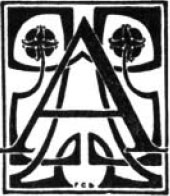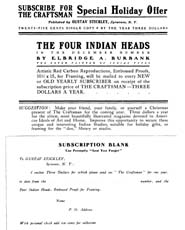click on each image to see full size
A Noted Painter of Indian Types
 MERICA has produced two distinguished painters of her primitive race of men. The first of these, George Catlin, from the very fact of being first in his chosen field of labor, no less than by reason of his artistic skill and fidelity, will always occupy a unique position. The second, Mr. Elbridge Ayer Burbank, now at the full tide of his activity, a superior artist and a close observer, can not be definitely judged, until time shall have placed his work in perspective.
MERICA has produced two distinguished painters of her primitive race of men. The first of these, George Catlin, from the very fact of being first in his chosen field of labor, no less than by reason of his artistic skill and fidelity, will always occupy a unique position. The second, Mr. Elbridge Ayer Burbank, now at the full tide of his activity, a superior artist and a close observer, can not be definitely judged, until time shall have placed his work in perspective.
Some years ago, he was commissioned by Mr. Edward E. Ayer (the enthusiastic (sic) student of Americana whose archeological and ethnological collections enrich the Field Museum, Chicago), to paint a portrait of Gernimo (sic), the noted Apache warrior, who was then at Fort Sill, Oklahoma.
The task was one which from its very difficulties, appealed to the artist, who, although somewhat experienced in portraiture, had never before attempted to paint an Indian. The chieftain, like all those of his race, was not at first willing to pose, and when once he had made this concession, offered other objections, such as those relating to the costume which had been chosen for him. But the artist gained his last point, and entered into the hunt for Gernimos (sic) personality, as keenly as General Miles had pursued the man himself, when he was the desperate and dreaded guerilla chieftain.
Mr. Burbank succeeded so well in rendering his difficult subject, that his commission was extended by Mr. Ayer, and he has since devoted himself to the portrayal of Indian types. I have several times found him pursuing his studies among the Indians of the Grand Canyon region, the Hopis, the Navajos, and at the Snake Dance. I last met him at Yuma, where he had just finished some admirable sketches of individuals of the tribe which lends its name to that remarkable town.
The secret of Mr. Burbank's success - setting aside his talent and skill as a painter lies, I believe, in his enthusiasm for his subjects. To acquaint himself with all branches of his work, to assure perfect accuracy of statement, he has visited more than fifty different tribes; painting on his journeys and always from life the portraits of nearly all the famous red men, including Chief Joseph, Red Cloud, Curley (General Custer's scout), Kopeli, the chief snake priest of Walpi, and Wiki, the priest of the Antelope fraternity.
First using oil paints exclusively, Mr. Burbank has lately produced excellent work in crayons, of which here, for the first time, he has permitted four fine characteristic heads to be reproduced.
The first portrait is that of Ho-mo-vi, one of the prominent Indians at Sichumavi, on the east mesa of the Hopi villages. Ho-mo-vi was, for many years, governor of the pueblo, and is a man of great determination and strength, as well as of sweetness of character; all of which qualities have been rendered by the artist with accuracy and distinction.
The second portrait presents the head of Shu-pe-la, the father of Kopeli and of Harry; the former, long the chief of the Snake Clan at Walpi, the latter, the successor to this high office. We have here a face denoting in its possessor firmness of purpose and great independence, which are revealed in the tightly closed lips and the salient chin.
The third head is that of A-a-wah, another Sichumavi Hopi. This warrior, many years since, lost one eye, in a struggle with marauding enemies, and to this loss he owes an aggressive, war-like air not usually characteristic of individuals of this people of peace. The likeness of the drawing is perfect, and in studying it, as well as all other Indian portraits coming from the hand of Mr. Burbank, we experience gratification at the thought that, through the power of art and character-reading, the shadow of these interesting primitive types will be reflected for the pleasure and instruction of those who shall come after us.
The one female head here offered is the portrait of Po-et-sah of the Tewan village of Hano. It represents a fine type of the primitive wife and mother, revealing the indications of tenderness, mental power and fortitude. As I have many times seen and spoken with the subject, I can personally testify to the truthfulness of the portrayal, as I can also to the distinction of the original.
The red races of America are fast perishing, and it is to be hoped that so sympathetic and successful a student of their lives, manners and customs as Mr. Burbank, will not allow himself to be lured back into civilization to take up a less important labor. May he continue and complete the work accomplished by Catlirt for art and ethnology!
G.W.J. [Note: George Wharton James]
[from pages 280-281]
[from page 359]
We wish our regular subscribers to pay particular heed to the announcement opposite p. 281 in regard to our Christmas offer of a set of Burbank's Indian Heads. We have prepared a special edition of artistic Proofs of these exquisite and artistic red carbon drawings, size 10 1/2 by 15, reproduced so that they are as near like the originals as modern skill and science can make them. These embossed proofs are on special paper, and are eminently suitable for framing to hang in den, library, studio, or bedroom. They are rare types of pleasing aboriginal faces, made by the modern Catlin, whose work is now acknowledged to be the most masterly of any that has the Indian for a theme. Send in your orders at once as the edition is limited, and note that to secure them you must be an old or new subscriber to The CRAFTSMAN. If your subscription has expired, renew at once. If you have not yet begun, now is the time. Send NOW, while you think of it, and while you may yet secure a set of these exquisite proofs. If you are already a subscriber send in a new subscription as a Christmas present for a friend.

Text and images from "The Craftsman" Magazine Collection used with permission:
Historical Works
Post Office Box 1003
Selma, Alabama 36702-1003